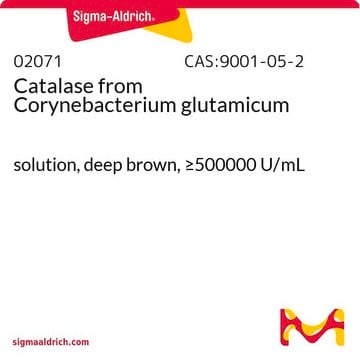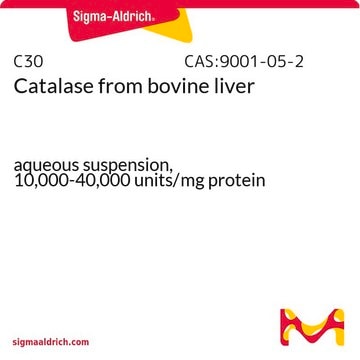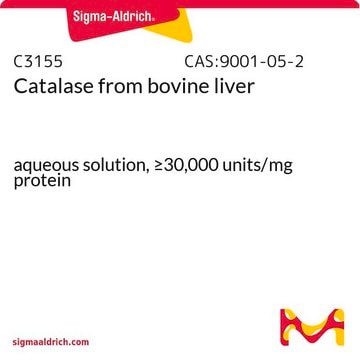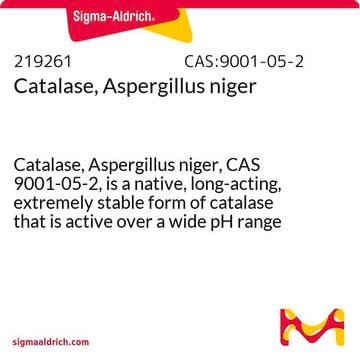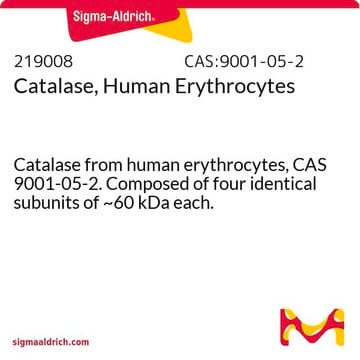60634
Catalase from Micrococcus lysodeikticus
solution, dark brown
Autenticatiper visualizzare i prezzi riservati alla tua organizzazione & contrattuali
About This Item
Prodotti consigliati
Origine biologica
bacterial (Micrococcus lysodeikticus)
Livello qualitativo
Forma fisica
solution
Attività specifica
65,000-150,000 U/mL
PM
Mr ~230000
tecniche
microbe id | metabolite detection: suitable
Colore
dark brown
Solubilità
0.05 M phosphate buffer pH 7.0: soluble, clear, brown (1:10)
N° accesso ID proteina
N° accesso UniProt
Condizioni di spedizione
wet ice
Temperatura di conservazione
2-8°C
InChI
1S/C9H10O3/c1-2-12-9(11)7-3-5-8(10)6-4-7/h3-6,10H,2H2,1H3
NUVBSKCKDOMJSU-UHFFFAOYSA-N
Descrizione generale
Research area: Cell Signaling
Catalase (CAT) is an antioxidant enzyme, encoded by the CAT gene family. The enzyme is ubiquitously expressed in most of the aerobic organisms.
Catalase (CAT) is an antioxidant enzyme, encoded by the CAT gene family. The enzyme is ubiquitously expressed in most of the aerobic organisms.
Applicazioni
Catalase from Micrococcus lysodeikticus has been used to eliminate excess of hydrogen peroxide production during sugar analog synthesis by in vitro biocatalytic cascade. It has also been used as a standard to evaluate oxidative stress by indirectly measuring catalytic activity.
Azioni biochim/fisiol
Catalase rapidly converts hydrogen peroxide to oxygen and water. It exhibits antioxidant activity and elicits a defense mechanism against reactive oxygen species (ROS). Catalase plays a role in neutralizing noxious hydrogen peroxide in nature as well as in various industries such as textile, pharma, and dairy. Micrococcus lysodeikticus catalase is a heme-containing protein.Catalase, along with various key cellular systems involved in hydrogen peroxide (H2O2) processing, plays a key role in regulating cellular redox balance and aids in cellular and intercellular signaling.
Definizione di unità
1 U corresponds to the amount of enzyme which decomposes 1 μmol H2O2 per minute at pH 7.0 and 25 °C
Avvertenze
Danger
Indicazioni di pericolo
Consigli di prudenza
Classi di pericolo
Resp. Sens. 1
Codice della classe di stoccaggio
10 - Combustible liquids
Classe di pericolosità dell'acqua (WGK)
WGK 1
Punto d’infiammabilità (°F)
Not applicable
Punto d’infiammabilità (°C)
Not applicable
Dispositivi di protezione individuale
Eyeshields, Gloves
Choose from one of the most recent versions:
Possiedi già questo prodotto?
I documenti relativi ai prodotti acquistati recentemente sono disponibili nell’Archivio dei documenti.
I clienti hanno visto anche
Catalase: A critical node in the regulation of cell fate
Baker A, et al.
Free Radical Biology & Medicine, 56-66 (2023)
Hessam Sepasi Tehrani et al.
Progress in biophysics and molecular biology, 140, 5-12 (2018-03-14)
Catalase is one of the firsts in every realm of biological sciences. At the same time it also has a number of unusual features. It has one of the highest turnover numbers of all enzymes. It is essential for neutralizing
Catalase (CAT) Gene Family in Rapeseed (Brassica napus L.): Genome-Wide Analysis, Identification, and Expression Pattern in Response to Multiple Hormones and Abiotic Stress Conditions
Raza A, et al.
International Journal of Molecular Sciences, 22(8) (2021)
Margarita Florencio et al.
Comparative biochemistry and physiology. Part A, Molecular & integrative physiology, 242, 110654-110654 (2020-01-12)
Organisms are exposed to multiple environmental factors simultaneously to which they often respond behaviorally, morphologically and/or physiologically. Amphibian larvae are quite plastic and efficiently adjust their phenotype and physiology to the reigning local conditions. Here we tested whether the combination
Ivan Gomez-Mestre et al.
PloS one, 8(12), e84266-e84266 (2013-12-21)
Many amphibian species exploit temporary or even ephemeral aquatic habitats for reproduction by maximising larval growth under benign conditions but accelerating development to rapidly undergo metamorphosis when at risk of desiccation from pond drying. Here we determine mechanisms enabling developmental
Il team dei nostri ricercatori vanta grande esperienza in tutte le aree della ricerca quali Life Science, scienza dei materiali, sintesi chimica, cromatografia, discipline analitiche, ecc..
Contatta l'Assistenza Tecnica.
